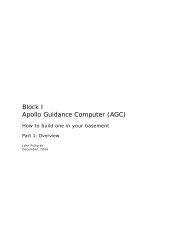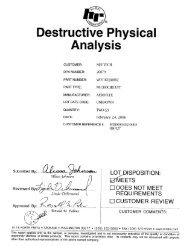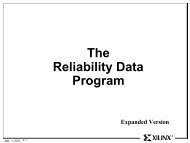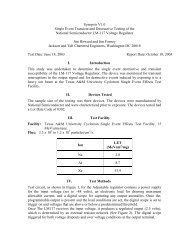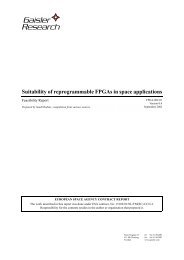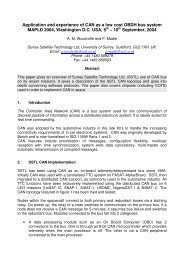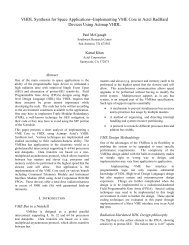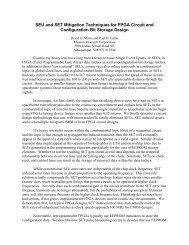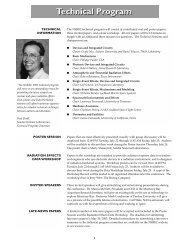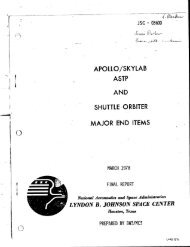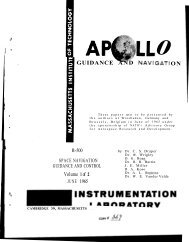Evaluation of Radiation Effects in Flash Memories Tetsuo Miyahira ...
Evaluation of Radiation Effects in Flash Memories Tetsuo Miyahira ...
Evaluation of Radiation Effects in Flash Memories Tetsuo Miyahira ...
You also want an ePaper? Increase the reach of your titles
YUMPU automatically turns print PDFs into web optimized ePapers that Google loves.
irradiation to 143 seconds at 12 krads for the worst <strong>of</strong> the<br />
six test devices.<br />
Supply current (Idd) degradation<br />
In the plot entitled “Supply Current (Idd)” shows that Idd<br />
for the Samsung device began to rise rapidly at about 8<br />
krads and the device failed functionally at about ~10<br />
krads. Idd for the Intel device began to rise rapidly at<br />
about 20 krads and the device failed functionally at<br />
~24 krads.<br />
V. SEU RESULTS<br />
SEU Tests<br />
Unpowered mode. The purpose <strong>of</strong> this test was to<br />
determ<strong>in</strong>e if the float<strong>in</strong>g gate would upset with heavy<br />
ions. <strong>Flash</strong> memories use an embedded microcontroller<br />
to improve erase/write times. The device was left<br />
unpowered, dur<strong>in</strong>g irradiation, to prevent upsets <strong>in</strong> the<br />
microcontroller, which <strong>in</strong> turn could cause an upsets <strong>in</strong><br />
the memory cells. The memory was loaded with a known<br />
pattern prior to the test and left unpowered while be<strong>in</strong>g<br />
irradiated with heavy ions. After the irradiation, the<br />
device was powered and tested to see if there were any<br />
changes to the pattern. No cell upset occurred when<br />
tested <strong>in</strong> this mode even up to an effective LET <strong>of</strong> 120<br />
MeV-cm 2 /mg.<br />
Static mode. For this mode, the flash memory was<br />
powered but there was no active address<strong>in</strong>g tak<strong>in</strong>g place<br />
dur<strong>in</strong>g irradiation. Most <strong>of</strong> the test<strong>in</strong>g was done us<strong>in</strong>g<br />
this mode. Before the irradiation, the device was loaded<br />
with a known pattern and at the completion <strong>of</strong> the<br />
irradiation, the device was tested to see if the memory<br />
content had changed. When test<strong>in</strong>g <strong>in</strong> this mode,<br />
functional <strong>in</strong>terrupts (SEFIs) would occur that <strong>in</strong> most<br />
cases required power cycl<strong>in</strong>g (turn<strong>in</strong>g Vdd <strong>of</strong>f and then on<br />
aga<strong>in</strong>) to clear the error condition. We were able to<br />
identify seven error modes (lockup conditions). Besides<br />
the seven error modes, three Intel devices had<br />
catastrophic high current condition that occurred dur<strong>in</strong>g<br />
functionality test after the irradiation was completed. We<br />
did not experience this catastrophic high current<br />
condition with the Samsung memories.<br />
We had no visibility <strong>of</strong> functionality dur<strong>in</strong>g irradiation,<br />
because we were not address<strong>in</strong>g the test device when<br />
tested <strong>in</strong> the static mode. Each irradiation run therefore<br />
became a pass or fail test. In order to determ<strong>in</strong>e a cross<br />
section, we selected fluence so that some <strong>of</strong> the runs<br />
resulted <strong>in</strong> a SEFI and some did not. Cross section was<br />
determ<strong>in</strong>ed by add<strong>in</strong>g the number <strong>of</strong> SEFIs then divid<strong>in</strong>g<br />
by the total fluence (passes as well as fails). The plot <strong>of</strong><br />
3<br />
the cross section as a function <strong>of</strong> LET for the Intel<br />
28F016SV is shown on the graph entitled “Cross Section<br />
for Complex Functional Upset Modes.” The error bars<br />
are large because we did not know at what po<strong>in</strong>t dur<strong>in</strong>g<br />
the irradiation the SEFI occurred or if more than one<br />
SEFI occurred dur<strong>in</strong>g that run.<br />
Read mode and erase/write mode. Most <strong>of</strong> the time<br />
was spent test<strong>in</strong>g <strong>in</strong> the static mode. The results from<br />
tests <strong>in</strong> read and erase/write modes were too limited to<br />
<strong>in</strong>clude <strong>in</strong> this paper. We will address these modes<br />
further <strong>in</strong> future tests.<br />
Isolat<strong>in</strong>g the memory array<br />
We used a copper shield to mask <strong>of</strong>f the microcontroller.<br />
The diagram entitled “Chip Micrograph” shows the area<br />
that was masked from the heavy ions. This was done to<br />
see if memory upsets would still occur. We got mixed<br />
results from this test, possibly because the sens<strong>in</strong>g and<br />
high voltage circuitry was <strong>in</strong>terspersed with the memory<br />
array, and could not be masked. With the Intel<br />
28F016SA memories, we observed no errors. The<br />
28F016SV (smart voltage) devices, however, did appear<br />
to exhibit memory errors at very high LET. However,<br />
the cross section was very low, and it is likely that the<br />
apparent memory errors are caused by the response <strong>of</strong> the<br />
more complex SV microcontroller. Accord<strong>in</strong>g to the<br />
manufacturer, the SV and SA memory cell technologies<br />
are identical and should have behaved similarly.<br />
VI. PLAN FOR FOLLOW ON TESTS<br />
X2000 Project<br />
X2000 Project is driv<strong>in</strong>g the flash memory survey. There<br />
are currently five missions proposed for X2000 project<br />
(Europa, Pluto, Solar Probe, Champollion, and a Mars<br />
mission). The <strong>Radiation</strong> <strong>Effects</strong> Group at JPL is<br />
primarily concerned with the Europa spacecraft because<br />
<strong>of</strong> its severe radiation environment. The Europa<br />
spacecraft is expected to be exposed to mostly electron<br />
dose <strong>of</strong> about four megarad(Si), beh<strong>in</strong>d 100 mils <strong>of</strong><br />
alum<strong>in</strong>um. Design trade studies <strong>in</strong>dicate that it is<br />
possible to shield to about 40 krad(Si) <strong>in</strong> order to ga<strong>in</strong> the<br />
advantages <strong>of</strong> us<strong>in</strong>g commercial flash and /or DRAMS as<br />
opposed to us<strong>in</strong>g an all radiation hardened SRAM. If we<br />
are able to f<strong>in</strong>d a suitable flash memory, the X2000<br />
modular architecture needs at least one giga-bit and<br />
would like eight giga-bits <strong>of</strong> flash memory for each<br />
spacecraft. The follow-on flash memory evaluation will<br />
be done <strong>in</strong> three steps, as described below.<br />
S<strong>in</strong>gle Event Latchup (SEL) test and cursory S<strong>in</strong>gle<br />
Event Upset (SEU) tests




